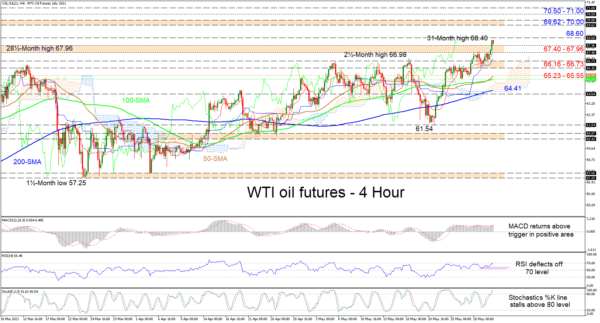WTI oil futures have propelled to a 31-month high of 68.40, overcoming the 68.00 handle, which had limited gains for around two-months. The bullish crossover of the 100-period simple moving average (SMA) by the 50-period one is suggesting positive sentiment is gaining some pace.
Although currently frozen, the Ichimoku lines are also reflecting the pickup in positive momentum. The short-term oscillators are skewed to the upside; however, are mirroring the slight pausing in bullish price action. The MACD is strengthening above its red trigger line, while the RSI has rebounded off the 70 level. The stochastic oscillator’s %K line is pointing lower in overbought territory but growing negative tendencies have yet to doomed significant for a deep pullback in the price.
If the price continues to retreat, early key support could arise from the 67.40-67.96 zone, while recoiling deeper, the commodity’s price could then encounter downside limitations around the vicinity of 66.16-66.73 – formed between the latest lows. Conceding further ground could drive the price towards the Ichimoku cloud coupled with a possible base shaped between the 50- and 100-period SMAs at 65.55 and 65.23, respectively.
If buyers retake the wheel, initial resistance could come from the 68.60 barrier, formed around mid-October 2018. Overstepping this could catapult the price towards the resistance belt of 69.62-70.00. Conquering this too, may then encourage buyers to challenge the buffer zone of 70.50-71.00, an area consisting of multiple inside swing lows around the early part of October 2018.
Summarizing, a hold above the 67.40-67.96 support zone could aid oil’s new found bullish charge in stretching towards the 70.00 handle. Yet, a retreat below it could delay near-term gains.













